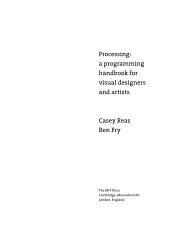Fractal.Invaders, Substrate (Interview with Jared Tarbell) - Processing
Fractal.Invaders, Substrate (Interview with Jared Tarbell) - Processing
Fractal.Invaders, Substrate (Interview with Jared Tarbell) - Processing
You also want an ePaper? Increase the reach of your titles
YUMPU automatically turns print PDFs into web optimized ePapers that Google loves.
Sketch_123.java The JAVA fi le generated by the preprocessor from the PDE fi le. This is the actual fi le that<br />
is compiled into the applet by the Java compiler used in <strong>Processing</strong>.<br />
Sketch_123.pde The original program fi le. It is linked from the index.html fi le.<br />
loading.gif An image fi le displayed while the program is loading in a Web browser.<br />
Every time a sketch is exported, the contents of the applet folder are deleted and the fi les<br />
are written from scratch. Any changes previously made to the index.html fi le are lost.<br />
Media fi les not needed for the applet should be deleted from the data folder before it is<br />
exported to keep the fi le size small. For example, if there are unused images in the data<br />
folder, they will be added to the JAR fi le, thus needlessly increasing its size.<br />
In addition to exporting Java applets for the Web, <strong>Processing</strong> can also export<br />
Java applications for the Linux, Macintosh, and Windows platforms. When “Export<br />
Application” is selected from the File menu, folders will be created for each of the<br />
operating systems specifi ed in the Preferences. Each folder contains the application, the<br />
source code for the sketch, and all required libraries for a specifi c platform.<br />
Additional and updated information about the <strong>Processing</strong> environment is available<br />
at www.processing.org/reference/environment or by selecting the “Environment” item<br />
from the Help menu of the <strong>Processing</strong> application.<br />
Example walk-through<br />
A <strong>Processing</strong> program can be be as short as one line of code and as long as thousands of<br />
lines. This scalability is one of the most important aspects of the language. The following<br />
example walk-through presents the modest goal of animating a sequence of diagonal<br />
lines as a means to explore some of the basic components of the <strong>Processing</strong> language. If<br />
you are new to programming, some of the terminology and symbols in this section will<br />
be unfamiliar. This walk-through is a condensed overview of the entire book, utilizing<br />
ideas and techniques that are covered in detail later. Try running these programs inside<br />
the <strong>Processing</strong> application to better understand what the code is doing.<br />
<strong>Processing</strong> was designed to make it easy to draw graphic elements such as lines,<br />
ellipses, and curves in the display window. These shapes are positioned <strong>with</strong> numbers<br />
that defi ne their coordinates. The position of a line is defi ned by four numbers, two for<br />
each endpoint. The parameters used inside the line() function determine the position<br />
where the line appears. The origin of the coordinate system is in the upper-left corner,<br />
and numbers increase right and down. Coordinates and drawing different shapes are<br />
discussed on pages 23–30.<br />
11 Using <strong>Processing</strong><br />
line(10, 80, 30, 40); // Left line<br />
line(20, 80, 40, 40);<br />
line(30, 80, 50, 40); // Middle line<br />
line(40, 80, 60, 40);<br />
line(50, 80, 70, 40); // Right line<br />
0-01



